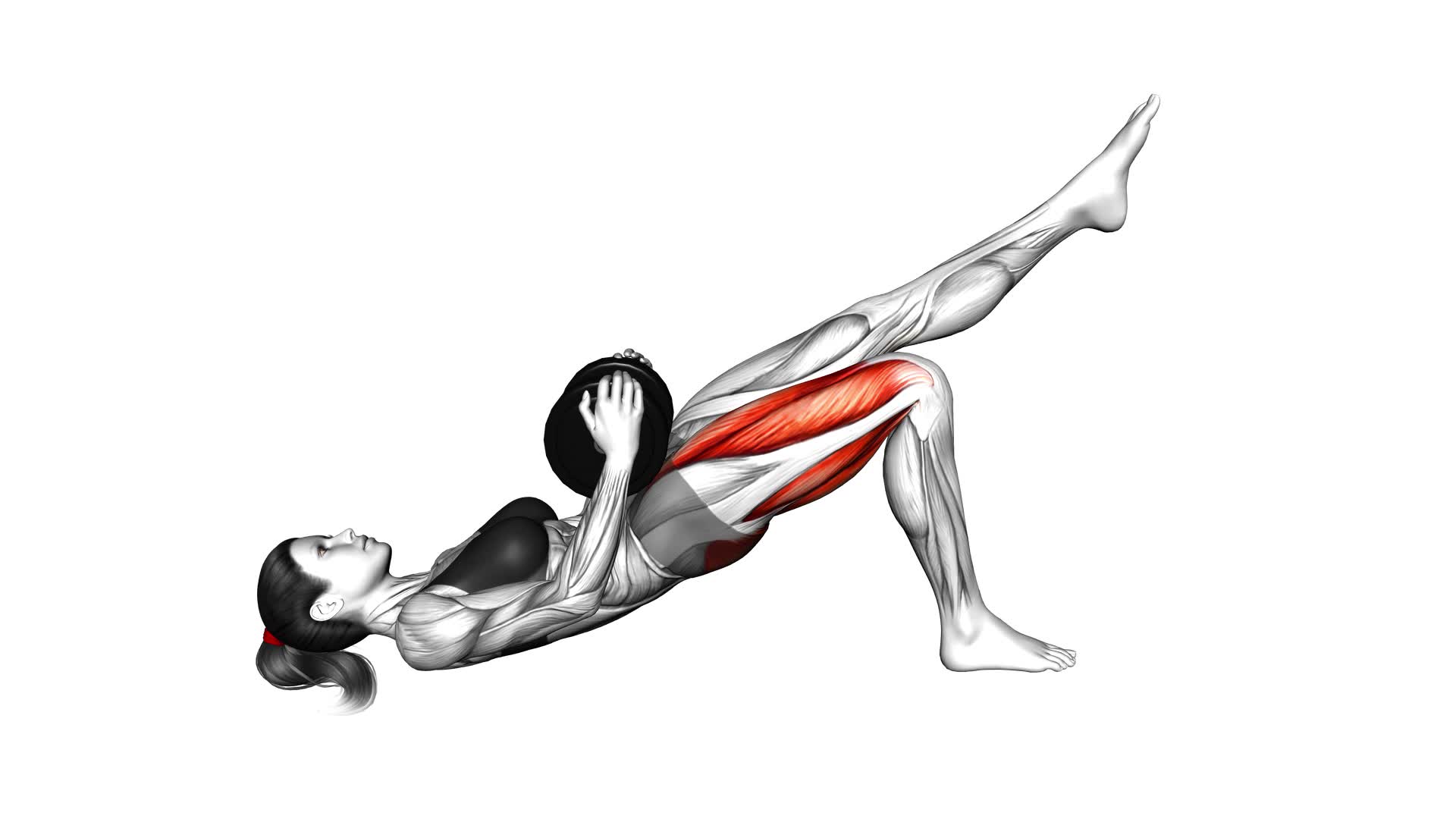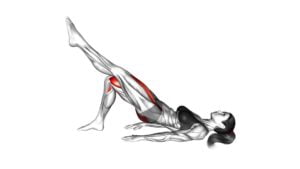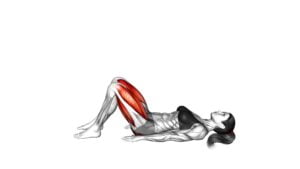Dumbbell Single Leg Glute Bridge (female) – Video Exercise Guide & Tips

Ready to strengthen and tone your glutes? Look no further than the dumbbell single leg glute bridge.
Watch This Exercise Video
In this exercise, you'll target your glute muscles while also improving stability and balance.
With a video exercise guide and helpful tips, you'll learn the proper form and technique to maximize your results.
Get ready to feel the burn and take your fitness routine to the next level with this challenging yet rewarding exercise.
Let's get started!
Key Takeaways
- Dumbbell Single Leg Glute Bridge effectively targets and activates glute muscles.
- It improves hip thrusts for better athletic performance.
- The exercise strengthens and tones the gluteus maximus, the largest glute muscle.
- Incorporating variations and progressions can increase intensity and continue progressing.
Benefits of the Dumbbell Single Leg Glute Bridge
You can maximize your glute strength and stability by incorporating the dumbbell single leg glute bridge into your workout routine. This exercise offers numerous benefits for your hips and glutes, making it a valuable addition to any fitness regimen.
One of the main benefits of the dumbbell single leg glute bridge is its ability to target and activate your glute muscles effectively. By performing this exercise, you can increase glute activation, which is essential for building strong and shapely glutes. This movement specifically targets the gluteus maximus, the largest muscle in your glutes, helping to strengthen and tone it.
Additionally, the dumbbell single leg glute bridge improves hip thrusts, which are essential for developing hip extension power. The hip thrust is a functional movement that mimics activities like running, jumping, and squatting. By incorporating the dumbbell single leg glute bridge into your routine, you can enhance your hip thrusts and improve your overall athletic performance.
Proper Form and Technique
To perform the dumbbell single leg glute bridge with proper form and technique, focus on maintaining a stable core and engaging your glute muscles throughout the movement. Here are some key tips to help you achieve optimal form and maximize the benefits of this exercise:
- Start by lying on your back with your knees bent and your feet flat on the ground.
- Hold a dumbbell in one hand and extend the opposite leg straight out in front of you.
- Press through your heel to lift your hips off the ground, squeezing your glutes at the top.
- Keep your core engaged and your body in a straight line from your shoulders to your knees.
- Avoid arching your lower back or letting your hips drop.
- Lower your hips back down to the ground in a controlled manner.
- Repeat the movement for the desired number of repetitions and then switch sides.
By focusing on maintaining a stable core and engaging your glute muscles, you won't only improve your balance but also activate the core muscles that support your spine. This exercise is an effective way to strengthen your glutes and improve overall lower body strength.
Now, let's move on to the next section, where we'll discuss variations and progressions of the dumbbell single leg glute bridge.
Variations and Progressions
Now, let's explore some ways to modify and advance the dumbbell single leg glute bridge exercise.
To challenge yourself and take your glute bridge to the next level, there are advanced variations you can try. One option is to incorporate resistance by using a heavier dumbbell or adding a resistance band around your thighs. This added resistance will increase the difficulty and intensity of the exercise, helping you to further strengthen and tone your glutes.
Another advanced variation is the single leg glute bridge with a hip thrust. In this variation, instead of lifting both legs off the ground, you'll keep one foot planted while lifting the other leg and performing a hip thrust. This exercise targets the glutes even more intensely, as well as engaging your core muscles for stability.
To further progress the exercise, you can try a single leg glute bridge on an unstable surface, such as a Bosu ball or a foam pad. This challenges your balance and stability, forcing your glutes to work harder to maintain control throughout the movement.
Remember to always maintain proper form and technique when performing these advanced variations. Start with a weight or variation that challenges you, but still allows you to maintain control and perform the exercise with proper form. As you become stronger and more comfortable, you can gradually increase the difficulty to continue progressing and achieving your fitness goals.
Common Mistakes to Avoid
While performing the dumbbell single leg glute bridge exercise, it's important to be aware of common mistakes to avoid. By avoiding these mistakes, you can ensure that you're maximizing the effectiveness of the exercise and reducing the risk of injury. Here are three common mistakes to be mindful of:
- Rounding your back: It's important to maintain a neutral spine throughout the exercise. Avoid letting your lower back round or arch excessively, as this can put unnecessary stress on your spine. Engage your core and focus on keeping your back straight.
- Not engaging your glutes: The main purpose of the exercise is to target and strengthen your glute muscles. Make sure you're actively squeezing your glutes at the top of the movement. This will help you get the most out of the exercise and prevent compensatory movements.
- Using too much weight: While it's important to challenge yourself, using too much weight can compromise your form and increase the risk of injury. Start with a weight that allows you to perform the exercise with proper technique. Gradually increase the weight as you become stronger and more comfortable.
Tips for Maximizing Results
To maximize your results with the dumbbell single leg glute bridge exercise, focus on proper form and incorporate these tips into your routine.
Firstly, pay attention to your diet. Eating a nutritious, well-balanced diet can help fuel your workouts and promote muscle growth. Include plenty of lean protein, fruits, vegetables, and whole grains in your meals to provide your body with the nutrients it needs to recover and build muscle.
In addition to diet recommendations, incorporating resistance bands into your glute bridge exercise can further enhance your results. Adding resistance bands around your thighs or just above your knees can increase the intensity of the exercise and target your glutes even more. The bands create resistance, forcing your glutes to work harder and leading to greater muscle activation.
Furthermore, make sure to maintain proper form throughout the exercise. Start by lying on your back with your knees bent and feet flat on the ground. As you lift your hips off the ground, squeeze your glutes and engage your core. Keep your back straight and avoid arching or straining your lower back. Lower your hips back down to the starting position in a controlled manner.
Frequently Asked Questions
How Many Sets and Reps Should I Do for the Dumbbell Single Leg Glute Bridge?
To get the most out of the dumbbell single leg glute bridge, you need to focus on the right sets and reps. The number of sets and reps will depend on your fitness level and goals.
Generally, starting with 2-3 sets of 10-12 reps per leg is a good place to begin. As you progress, you can increase the sets and reps to challenge your glutes even more.
This exercise is great for glute activation and can help strengthen and tone your glutes.
Can I Perform the Dumbbell Single Leg Glute Bridge With a Barbell Instead of Dumbbells?
Yes, you can perform the dumbbell single leg glute bridge with a barbell instead of dumbbells. Barbell variations can add more resistance and challenge to the exercise. However, using dumbbells has its own benefits.
Dumbbells allow for better isolation of the glutes and provide a more stable grip. Additionally, they offer greater versatility and are easier to control.
Ultimately, it's up to you to decide which equipment suits your preferences and goals.
Are There Any Modifications for People With Knee or Hip Issues?
If you have knee or hip issues, there are modifications you can make to the dumbbell single leg glute bridge exercise.
You could try using a resistance band around your thighs to help stabilize your hips and take some pressure off your knees.
Another option is to perform the exercise with both feet on the ground instead of lifting one leg.
This will still engage your glutes and help with overall lower body strength.
Can This Exercise Help in Reducing Lower Back Pain?
Yes, the Dumbbell Single Leg Glute Bridge can help in reducing lower back pain. By activating and strengthening the glute muscles, this exercise can improve your overall stability and support for the lower back. Additionally, it helps to correct muscle imbalances and promotes proper alignment.
To further customize the exercise, you can vary the weight of the dumbbell or try different leg positions. Remember to consult with a fitness professional before starting any exercise program, especially if you have existing lower back issues.
Is It Necessary to Use a Dumbbell for the Dumbbell Single Leg Glute Bridge, or Can I Do It Without Any Weights?
Yes, you can definitely do the dumbbell single leg glute bridge without any weights. It's not necessary to use a dumbbell for this exercise. The main benefit of this exercise is that it targets and strengthens your glute muscles, helping to tone and shape your buttocks.
However, if you want to add some extra resistance and challenge yourself, you can incorporate a dumbbell into the exercise.
There are various variations of this exercise that you can try to keep things interesting and work different muscle groups.
Conclusion
In conclusion, the dumbbell single leg glute bridge is a highly effective exercise for targeting and strengthening the glute muscles. By using proper form and technique, variations and progressions can be added to increase the intensity of the exercise.
It's important to avoid common mistakes and follow tips for maximizing results. Incorporating this exercise into your routine can lead to improved glute strength and overall fitness.

Author
Years ago, the spark of my life’s passion ignited in my mind the moment I stepped into the local gym for the first time. The inaugural bead of perspiration, the initial endeavor, the very first surge of endorphins, and a sense of pride that washed over me post-workout marked the beginning of my deep-seated interest in strength sports, fitness, and sports nutrition. This very curiosity blossomed rapidly into a profound fascination, propelling me to earn a Master’s degree in Physical Education from the Academy of Physical Education in Krakow, followed by a Sports Manager diploma from the Jagiellonian University. My journey of growth led me to gain more specialized qualifications, such as being a certified personal trainer with a focus on sports dietetics, a lifeguard, and an instructor for wellness and corrective gymnastics. Theoretical knowledge paired seamlessly with practical experience, reinforcing my belief that the transformation of individuals under my guidance was also a reflection of my personal growth. This belief holds true even today. Each day, I strive to push the boundaries and explore new realms. These realms gently elevate me to greater heights. The unique combination of passion for my field and the continuous quest for growth fuels my drive to break new ground.







